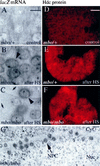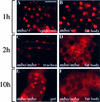members only encodes a Drosophila nucleoporin required for rel protein import and immune response activation
- PMID: 10921908
- PMCID: PMC316830
members only encodes a Drosophila nucleoporin required for rel protein import and immune response activation
Abstract
Many developmental and physiological responses rely on the selective translocation of transcriptional regulators in and out of the nucleus through the nuclear pores. Here we describe the Drosophila gene members only (mbo) encoding a nucleoporin homologous to the mammalian Nup88. The phenotypes of mbo mutants and mbo expression during development are cell specific, indicating that the nuclear import capacity of cells is differentially regulated. Using inducible assays for nucleocytoplasmic trafficking we show that mRNA export and classic NLS-mediated protein import are unaffected in mbo mutants. Instead, mbo is selectively required for the nuclear import of the yeast transcription factor GAL4 in a subset of the larval tissues. We have identified the first endogenous targets of the mbo nuclear import pathway in the Rel proteins Dorsal and Dif. In mbo mutants the upstream signaling events leading to the degradation of the IkappaB homolog Cactus are functional, but Dorsal and Dif remain cytoplasmic and the larval immune response is not activated in response to infection. Our results demonstrate that distinct nuclear import events require different nucleoporins in vivo and suggest a regulatory role for mbo in signal transduction.
Figures







Similar articles
-
Regulated nuclear import of Rel proteins in the Drosophila immune response.Nature. 1998 Mar 5;392(6671):93-7. doi: 10.1038/32195. Nature. 1998. PMID: 9510254
-
The Drosophila nucleoporin DNup88 localizes DNup214 and CRM1 on the nuclear envelope and attenuates NES-mediated nuclear export.J Cell Biol. 2003 Nov 24;163(4):701-6. doi: 10.1083/jcb.200304046. J Cell Biol. 2003. PMID: 14638854 Free PMC article.
-
The Drosophila homolog of NTF-2, the nuclear transport factor-2, is essential for immune response.EMBO Rep. 2002 Apr;3(4):378-83. doi: 10.1093/embo-reports/kvf072. EMBO Rep. 2002. PMID: 11943764 Free PMC article.
-
Nuclear import of the Drosophila Rel protein Dorsal is regulated by phosphorylation.Genes Dev. 1999 Mar 1;13(5):556-68. doi: 10.1101/gad.13.5.556. Genes Dev. 1999. PMID: 10072384 Free PMC article.
-
The Dorsal-related immunity factor (Dif) can define the dorsal-ventral axis of polarity in the Drosophila embryo.Development. 1998 Jun;125(11):2159-69. doi: 10.1242/dev.125.11.2159. Development. 1998. PMID: 9570779
Cited by
-
Dysfusion transcriptional control of Drosophila tracheal migration, adhesion, and fusion.Mol Cell Biol. 2006 Sep;26(17):6547-56. doi: 10.1128/MCB.00284-06. Mol Cell Biol. 2006. PMID: 16914738 Free PMC article.
-
Cell-Mediated Branch Fusion in the Drosophila Trachea.Results Probl Cell Differ. 2024;71:91-100. doi: 10.1007/978-3-031-37936-9_5. Results Probl Cell Differ. 2024. PMID: 37996674 Review.
-
Nuclear pore complex component MOS7/Nup88 is required for innate immunity and nuclear accumulation of defense regulators in Arabidopsis.Plant Cell. 2009 Aug;21(8):2503-16. doi: 10.1105/tpc.108.064519. Epub 2009 Aug 21. Plant Cell. 2009. PMID: 19700630 Free PMC article.
-
A nuclear targeting system in Plasmodium falciparum.Malar J. 2010 May 14;9:126. doi: 10.1186/1475-2875-9-126. Malar J. 2010. PMID: 20470378 Free PMC article.
-
Nuclear pore proteins and cancer.Semin Cell Dev Biol. 2009 Jul;20(5):620-30. doi: 10.1016/j.semcdb.2009.03.003. Epub 2009 Mar 18. Semin Cell Dev Biol. 2009. PMID: 19577736 Free PMC article. Review.
References
-
- Aspland SE, White RA. Nucleocytoplasmic localisation of extradenticle protein is spatially regulated throughout development in Drosophila. Development. 1997;124:741–747. - PubMed
-
- Bray SJ, Kafatos FC. Developmental function of Elf-1: An essential transcription factor during embryogenesis in Drosophila. Genes & Dev. 1991;5:1672–1683. - PubMed
-
- Briggs LJ, Stein D, Goltz J, Corrigan VC, Efthymiadis A, Hübner S, Jans DA. The cAMP-dependent protein kinase site (Ser312) enhances dorsal nuclear import through facilitating nuclear localization sequence/importin interaction. J Biol Chem. 1998;273:22745–22752. - PubMed
Publication types
MeSH terms
Substances
LinkOut - more resources
Full Text Sources
Other Literature Sources
Molecular Biology Databases
